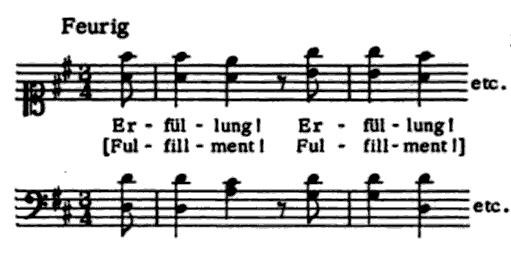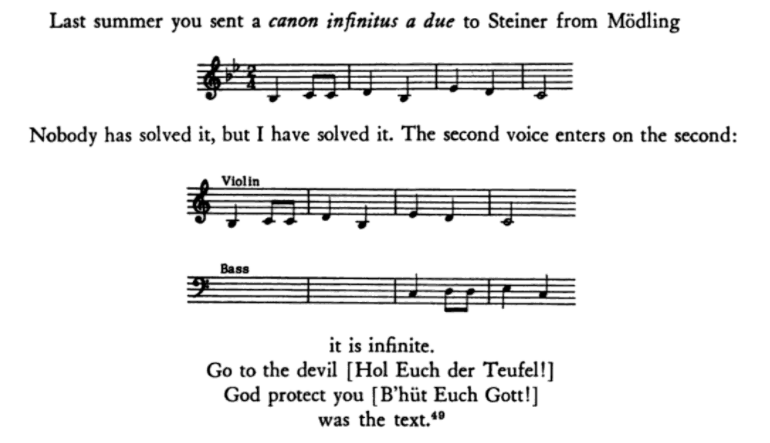By 1819, Beethoven’s work on folksong settings was dwindling. Although he finished 4 more batches in 1819 and early 1820 (Groups XV to XVIII in Barry Cooper’s chronological catalog) these amount to only 10 settings, and none of them are available in live YouTube performances.
The year 1819 was a good one for the clerical career of the Archduke Rudolph. On 24 April he was made a Cardinal in the Catholic Church, and on 4 June he became Archbishop of Olmütz. Beethoven wrote his letter of congratulations soon thereafter:
However numerous may be the congratulations which have been pouring in to you, my most gracious lord … I too cannot but add my congratulations to the many others … (Beethoven Letters, #948)
Beethoven added a four-part chorus singing “Fulfillment!”:

This tiny fragment is catalogued as WoO 205e, one of ten such short musical greetings that appear in Beethoven’s letters and conversation books. The tune is reminiscent of the “O Hoffnung” theme that Beethoven wrote for the Archduke’s variations (Day 308).
Beethoven also promised the Archduke a major composition to be performed a year hence when Rudolph’s elevation to Archbishop would be solemnized. Beethoven seems to be fully confident that he won’t blow the deadline:
The day on which a High Mass composed by me will be performed during the ceremonies solemnized for Your Imperial Highness will be the most glorious day of my life; and God will enlighten me so that my poor talents may contribute to the glorification of that solemn day.
According to Anton Schindler, while Beethoven was in Mödling during the summer of 1819, he wrote some waltzes for a band of seven musicians. In 1905, these were discovered and published. They’re called the Mödling Dances and catalogued as WoO 17.
However, due to the unreliable testimony of Schindler and the quality of the dances themselves, it is now generally assumed that they are spurious. See this discussion on the Beethoven-Haus site.
#Beethoven250 Day 316
11 Mödling Dances (WoO 17), 1819?
A studio recording of these likely spurious waltzes, minuets, and Ländler.
Beethoven composed four tiny canons during 1819, among them the puzzle canon “Hol’ euch der Teufel! B’hüt’ euch Gott!” (WoO 173) for his music publisher Sigmund Anton Steiner sometime in the summer. The text translates as “Devil take you! God protect you!”
#Beethoven250 Day 316
Canon “Hol’ euch der Teufel” (WoO 173), 1819
An ad may precede a two-part solution to this puzzle canon.
We only know about Beethoven’s WoO 173 canon indirectly: Beethoven was using conversation books by this time so that people could write down comments and questions to him. In one dated 20 March 1820, someone (possibly Carl Czerny) wrote:

That’s from Thayer-Forbes, p. 744. Notice that the comment in the conversation book establishes both the date of the original puzzle canon and the recipient. A two-part solution is shown but apparently a four-part solution is also possible.
Beethoven presented the four-part canon “Glaube und Hoffe” (“Faith and Hope,” WoO 174) to music publisher Moritz Schlesinger on 21 September 1819. Beethoven-Haus has the autograph score.
#Beethoven250 Day 316
Canon “Glaube und Hoffe” (WoO 174), 1819
An animated score accompanies this four-part canon.
In the fall of 1819, Beethoven sat for a portrait by Ferdinand Schimon. Of this portrait, Anton Schindler wrote:
From an artistic point of view Schimon’s work is not a distinguished work of art, yet full of characteristic truth. In the rendering of that particular look, the majestic forehead, this dwelling-place of mighty, sublime ideas, of hues, in the drawing of the firmly shut mouth and the chin shaped like a shell, it is truer to nature than any other portrait. (Thayer-Forbes, p. 742)

Two Beethoven canons date from year-end 1819. Beethoven composed the canon “Glück zum neuen Jahr!” (“Happy New Year,” WoO 176) for Countess Erdödy, and sent it to her on 31 December 1819.
#Beethoven250 Day 316
Canon “Glück zum neuen Jahr” (WoO 176), 1819
An animated score accompanies this three-part canon.
Beethoven’s “Seiner Kaiserlichen Hoheit!” (WoO 179) is a New Year’s greeting for the Archduke Rudolph. The text translates as “To His Imperial Highness! To Archduke Rudolph! To the prince of the clergy! All is good, all is fine.” Only the last part is a canon.
#Beethoven250 Day 316
Canon “Seiner kaiserlichen Hoheit” (WoO 179), 1819
An animated score accompanies this choral prelude followed by a four-part canon on the words “Alles Gute, alles Schöne!”